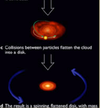Final Flashcards
(88 cards)
Ptolemaic Model
Each planet moves around Earth on a small circle (epicycle) that turns upon a larger circle (deferent).

Convection
Transportation of energy through the rising of hot plasma and the sinking of cool plasma.

Proton-Proton Chain
Nuclear fusion reactions by which stars convert hydrogen to helium. These reactions produce solar neutrinos.

Gravitational Equalibrium
The condition of a star in which the weight of overlying layers at each point is balanced by the total pressure at that point.

Oort Cloud
Second cometary region. The Outer limit of the Oort cloud defines the cosmographical boundary of the Solar System and the region of the Sun’s gravitational dominance. (1/4 the way to the nearest star).

Asteroid Belt
A region of asteroids located between the orbits of Mars and Jupiter.

Fusion
A union caused by heat. The merging of different elements into an ion. Nuclei combine to form more massive nucleous with the simultaneous release of energy.

Fission
The splitting of something into two parts. The nucleus of an atom splits into smaller parts, releasing a very large amount of energy.

Asteroid
Rocky leftovers from the era of planet formation that orbit the sun.

- Meteorite
- Primitive Meteorite
- Processed Meteorites
- Meteor
- A rock from space that falls
through Earth’s atmosphere. - Remnants from solar nebula.
- Fragments of larger bodies that underwent differentiation.
- The bright trail left by a meteorite.

Comet
Formed beyond the frost line, comets are icy
counterparts to asteroids. Only the ones that pass into the solar system grow trails from the sun melting them.

Hot Jupitar
A class of extrasolar planets whose characteristics are similar to Jupiter, however, with high surface temperatures because they orbit very close to their parent stars.

Trojan Asteroids
A large group of objects that share the orbit of the planet Jupiter around the Sun.

Extrasolar Planet
A planet outside the Solar System.

Doppler Effect
The change in frequency of a wave (or other periodic event) for an observer moving relative to its source. We can messure the speed of a distant object using this; by messuring the blue/redshift

Solar Neutrino
They are electron neutrinos that are produced in the Sun as a product of nuclear fusion, mainly contributed by proton-proton chain reactions.

Astronomy
Science that deals with the study of celestial objects; the physics, chemistry, and evolution of such objects; and phenomena that originate outside the atmosphere of Earth.

Sunspots
Temporary phenomena on the photosphere of the Sun that appear visibly as dark spots. They’re caused by intense magnetic activity, which inhibits convection, forming areas of reduced surface temperature.

Solar Wind
a stream of charged particles released from the upper atmosphere of the Sun. It mostly consists of electrons and protons with high energies.

Habitable Zone
The region around a star within which it is theoretically possible for a planet with sufficient atmospheric pressure to maintain liquid water on its surface.

Comet Plasma Tail
Comets sometimes exhibit two tails, one being the grey and the other usually blue. The grey one is caused by light refecting off dust that the comet is releasing, and is not always present. The blue is the PLASMA TAIL and is caused by CO2 ion emission from the melting by the sun.

Ratioactive Dating
A technique used to date materials such as rocks, usually based on a comparison between the observed abundance of a naturally occurring radioactive isotope and its decay products, using known decay rates.

Greenhouse Effect
a process by which thermal radiation from a planetary surface is absorbed by atmospheric greenhouse gases, and is re-radiated in all directions. Since part of this re-radiation is back towards the surface and the lower atmosphere, it results in an elevation of the average surface temperature above what it would be in the absence of the gases.

Greenhouse Gases
Gas in an atmosphere that absorbs and emits radiation within the thermal infrared range. The primary greenhouse gases in the Earth’s atmosphere are water vapour, carbon dioxide, methane, nitrous oxide, and ozone.















































